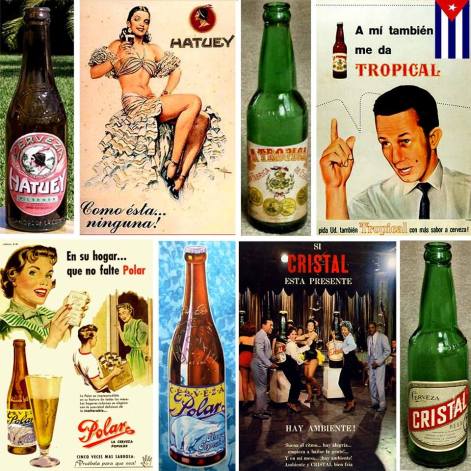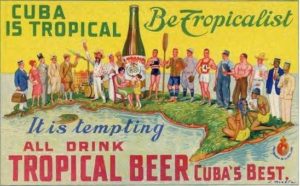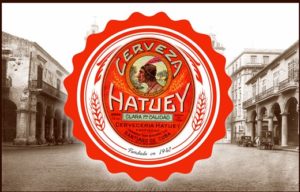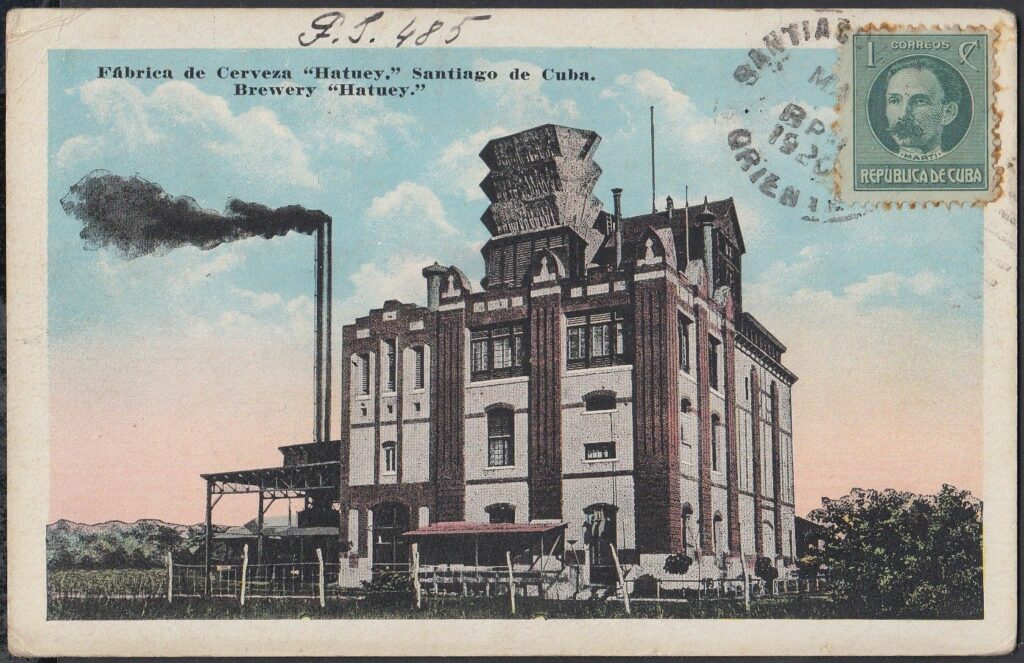
LAS CERVEZAS CUBANAS, UNA VIEJA INDUSTRIA Y SU YA OLVIDADA MAGNÍFICA PRODUCCIÓN NACIONAL. FOTOS.
Hasta el siglo XVIII, en Cuba sólo se bebían vinos, sidras, licores, rones y destilados de caña de azúcar. La cerveza no se consumía bajo la dominación política, económica y cultural del imperio colonial español.
Los historiadores coinciden en que el ingreso regular de cerveza al país caribeño se dio a través del contrabando por la zona central y oriental, posiblemente desde Jamaica, territorio bajo dominio de la Corona inglesa.
Con la Toma de La Habana por los ingleses a partir de 1762, esta bebida se popularizó, ya que era la que bebían tradicionalmente los soldados británicos. Desde entonces, comenzó a importarse de forma legal y hasta 130 marcas internacionales ingresaron al territorio nacional que competirían por lograr el favoritismo de los criollos.
La primera cerveza ingresó a la Isla por la Provincia de Oriente y fue contrabandeada desde Jamaica.
Había cervezas que se anunciaban como propias para la familia, incluso llegaron a recomendarlas para niños y mujeres en periodo de lactancia. Las damas, según la prensa de la época, preferían la marca británica “Ale”: suave, clara y beneficiosa, decían, para los problemas estomacales. De todas formas, era una de las cervezas más populares, junto con la “Cabeza de Perro”, también inglesa. Alrededor de 1850, la marca Tennet Lager era tan popular entre los consumidores que muchos cubanos llamaban al líquido espumoso “lager”.
COMIENZA LA VIEJA CERVEZA CUBANA.
La cerveza cubana nació en 1841 cuando Juan Manuel Asbert y Calixto García comenzaron a producirla en una fábrica de la calle San Rafael esquina con Águila. Se intentó elaborarlo con jugo de caña de azúcar, que sustituiría a la cebada europea, pero el intento fue un fracaso y desde ese momento los criollos se contentaron con embotellar el refrescante líquido que llegaba en barriles desde el extranjero.
Así se hizo hasta 1883 cuando se instaló una fábrica en la ciudad matancera de Cárdenas para producirlo. No duró mucho, pero en 1888 el aumento de los impuestos de importación aconsejó a los comerciantes del patio prepararlo en Cuba. Así surgió en Puentes Grandes “La Tropical”, la primera cerveza cubana, con un producto de baja calidad. La mejora no tardó mucho en llegar, cuando maestros cerveceros franceses y alemanes especialmente contratados acabaron dando a la cerveza el “toque” necesario.
En 1888 se fundó en La Habana la llamada “Nueva Fábrica de Hielo”, articulada poco después a la cervecería de Puentes Grandes. Allí comenzó a producirse “La Tropical”, bajo la propiedad de Ramón Herrera Sancibían, bisabuelo de Julio Blanco Herrera, quien con su tesón logró luego producir el cincuenta y ocho por ciento de lo que se producía anualmente en el país durante los años cincuenta.
NUESTRA FORMIDABLE INDUSTRIA CERVECERA.
En sus inicios las marcas en el mercado eran cerveza clara “La Tropical”, Dark Tropical “Excelsior”, cerveza clara “Cristal Palatino”, cerveza oscura tipo Munich “Tivoli” y “Maltina Tivoli”. La exquisitez de la marca trascendió las costas de la isla para conquistar premios en Europa y Estados Unidos, siendo los más significativos el Gran Premio en las Exposiciones Internacionales de Londres, en 1896, y Bruselas, en 1897; Diploma y Gran Premio en la Exposición Internacional del Progreso, París, 1912; Medalla de Oro en la Exposición de Agricultura e Industrias de La Habana, en 1909 y 1911; Medalla de bronce en la Exposición de San Luis de 1904, y sus medallas estaban expuestas en el antiguo rótulo.
En un terreno anexo a la fábrica, Julio Blanco Herrera padre construyó en 1929 el estadio “La Tropical”, hoy Pedro Marrero. Este campo sirvió como sede de los Segundos Juegos Centroamericanos y del Caribe, celebrados en 1940.
Hubo otros muy populares, como “Hatuey” y “Polar”. El primero tenía en su etiqueta un aborigen cubano y el segundo un oso blanco. Se promocionaban así: “La cerveza del pueblo y el pueblo nunca se equivoca”. Por su exquisito sabor, sus magníficas condiciones digestivas y sus resultados tonificantes.
La otra marca afirmó: “Pregunta por Hatuey. La gran cerveza de Cuba”, mientras la publicidad de Cristal insistía: “¡Cómo anima! ¡Qué alegría! ¡Cómo estimula! Una cerveza extraordinaria”. Todo era una cuestión de preferencia. Existían cervezas importadas, pero no tuvieron mucha aceptación, a pesar de que algunas marcas de origen americano se presentaban en latas; toda una novedad en aquel momento.
EMPRESA CERVECERA DE SANTIAGO DE CHIBAS
Antes de 1919, la “Compañía Cervecera Santiago” fue fundada por el señor Eduardo Chibas. Durante este año, bajo la dirección de Don Enrique Schueg y Chassin, las instalaciones fueron adquiridas por la “Compañía Ron Bacardí SA”. La cervecería “Hatuey”, ubicada en el barrio San Pedrito de Santiago de Cuba, fue adquirida con el único fin de construir una nueva destilería Bacardí. La nueva destilería fue inaugurada el 4 de febrero de 1922.
En sus primeros 21 años, la producción y ventas de la cervecería San Pedrito de Santiago de Cuba se quintuplicaron. Para satisfacer la creciente sed de Cuba por la Cerveza “Hatuey”, en 1947 se creó la Cervecería Modelo. Esta cervecería fue construida en 1947 a diez millas de La Habana en “El Cotorro”. Fiel a su nombre, en realidad era una cervecería modelo.
La calidad de la cerveza cubana era tal que las contrapartes extranjeras no lograron penetrar el mercado interno. Nadie podía competir en precio y calidad de las cervezas cubanas a pesar de que algunas firmas extranjeras lo intentaron.
En 1958, Cuba poseía cinco cervecerías que producían alrededor de 30 millones de litros al año para una población de aproximadamente 6 millones de habitantes. Si se tiene en cuenta el reducido consumo del producto por parte de mujeres y menores, se puede inferir el elevado consumo per cápita del producto entre los bebedores. El cubano siempre ha tenido predilección por esta bebida.
El mayor consumo de cerveza se daba en bares y cantinas y algunos preferían hacerlo en la bodega de la esquina. Allí, en un ambiente “familiar”, conversaron con el dependiente saboreando una cerveza espumosa, un vaso de “lager” con un “saladito” de jamón y queso o con unas aceitunas, mientras sonaba en la victrola el bolero del momento. ¿No es el lugar ideal?


THE CUBAN BEERS, AN OLD INDUSTRY AND ITS NOW FORGOTTEN MAGNIFICENT NATIONAL PRODUCTION. PHOTOS.
Until the 18th century, in Cuba only wines, ciders, liqueurs, rums and sugar cane distillates were drunk. Beer was not consumed under the political, economic and cultural domination of the Spanish colonial empire.
Historians agree that the regular entry of beer into the Caribbean country occurred through smuggling through the central and eastern area, possibly from Jamaica, a territory under the rule of the English Crown.

With the Capture of Havana by the English starting in 1762, this drink became popular, as it was what British soldiers traditionally drank. Since then, it began to be imported legally and up to 130 international brands entered the national territory that would compete to achieve the favoritism of the Creoles.
The first beer entered the Island from the Oriente Province and was smuggled from Jamaica.
There were beers that were advertised as their own for the family, they even went so far as to recommend them for children and women in the lactation period. The ladies, according to the press of the time, favored the British brand “Ale”: soft, clear and beneficial, they said, for stomach problems. In any case, it was one of the most popular beers, along with the “Cabeza de Perro”, also English. Around 1850, the Tennet Lager brand was so popular among consumers that many Cubans call the sparkling liquid “lager”.
THE OLD CUBAN BEER BEGINS.
Cuban beer was born in 1841 when Juan Manuel Asbert and Calixto García began producing it in a factory on Calle San Rafael on the corner of Águila. They tried to make it with the juice of sugar cane, which would replace European barley, but the attempt was a failure and from that moment the Creoles were content to bottle the refreshing liquid that came in barrels from abroad.
This was done until 1883 when a factory was installed in the Matanzas city of Cárdenas to produce it. It did not last long, but in 1888 the increase in import taxes advised the merchants of the patio to prepare it in Cuba. Thus emerged in Puentes Grandes, “La Tropical”, the first Cuban beer, with a low-quality product. It wouldn’t take long to improve when specially recruited French and German master brewers ended up giving beer the necessary “touch”.
In 1888 the so-called “New Ice Factory” was founded in Havana, articulated shortly afterward to the brewery in Puentes Grandes. There, “La Tropical” began to be produced, under the ownership of Ramón Herrera Sancibían, Julio Blanco Herrera’s great-grandfather, who with his tenacity later managed to produce fifty-eight percent of what was produced annually in the country during the 1950s.
OUR FORMIDABLE BREWING INDUSTRY.
In the beginning, the brands on the market were light beer “La Tropical”, Dark Tropical “Excelsior”, light beer “Cristal Palatino”, dark Munich type beer “Tivoli” and “Maltina Tivoli”. The exquisiteness of the brand transcended the coasts of the island to win prizes in Europe and the United States, the most significant being the Grand Prix at the International Exhibitions in London, in 1896, and Brussels in 1897; Diploma and Grand Prize at the International Exhibition of Progress, Paris, 1912; Gold Medal at the Exhibition of Agriculture and Industries of Havana, in 1909 and 1911; Bronze medal at the Exhibition of San Luis, 1904, and his medals were exhibited on the old label.
On land attached to the factory, Julio Blanco Herrera Sr. built the “La Tropical” stadium in 1929, today Pedro Marrero. This field served as the venue for the Second Central American and Caribbean Games, held in 1940.
There were other very popular ones, like “Hatuey” and “Polar”. The first one had a Cuban aboriginal on its label, and the second one a white bear. They promoted themselves like this: “The people’s beer and the people are never wrong.” For its exquisite flavor, its magnificent digestive conditions and its invigorating results.
The other brand claimed: “Ask for Hatuey. The great beer of Cuba “, while Cristal advertising insisted:” How it animates! How glad! How it stimulates! An extraordinary beer ”. It was all a matter of preference. There were imported beers, but they were not widely accepted, despite the fact that some brands of American origin were presented in cans; quite a novelty at the time.

CHIBAS’S SANTIAGO BREWING COMPANY
Before 1919, the “Santiago Brewing Company” was founded by Mr. Eduardo Chibas. During this year, under the direction of Don Enrique Schueg and Chassin, the facilities were acquired by the “Compañía Ron Bacardí SA”. The “Hatuey” brewery, located in the San Pedrito neighborhood of Santiago de Cuba, was purchased for the sole purpose of building a new Bacardí distillery. The new distillery was inaugurated on February 4, 1922.
In its first 21 years, production and sales at the San Pedrito brewery in Santiago de Cuba increased five times. In order to satisfy Cuba’s growing thirst for “Hatuey” Beer, the Model Brewery was created in 1947. This brewery was built in 1947 ten miles from Havana in “El Cotorro”. True to its name, it was in fact a model brewery.
The quality of the Cuban beer was such that the foreign counterparts failed to penetrate the domestic market. No one could compete on price and quality of Cuban beers despite the fact that some foreign firms tried.
By 1958, Cuba owned five breweries that produced about 30 million liters per year for a population of approximately 6 million inhabitants. If the reduced consumption of the product by women and minors is taken into account, the high per capita consumption of the product among drinkers can be inferred. Cuban has always had a predilection for this drink.
The greatest consumption of beer took place in bars and canteens and some preferred to do it in the “bodega” on the corner. There, in a “family” atmosphere, they conversed with the clerk savoring a foamy beer, a glass of “lager” with a “saladito” of ham and cheese or with some olives, while the bolero of the moment sounded in the victrola. Isn’t it the ideal place?

Agencies/ Wiki/ CubanBeersHist./ Extractos/ Excerpts/ Internet Photos/ Arnoldo Varona/ www.TheCubanHistory.com

THE CUBAN HISTORY, HOLLYWOOD.




 LAS CERVEZAS CUBANAS, una vieja Industria y su ya olvidada magnífica producción Nacional. PHOTOS. * THE CUBAN BEERS, AN OLD INDUSTRY AND ITS NOW FORGOTTEN MAGNIFICENT NATIONAL PRODUCTION. PHOTOS.
LAS CERVEZAS CUBANAS, una vieja Industria y su ya olvidada magnífica producción Nacional. PHOTOS. * THE CUBAN BEERS, AN OLD INDUSTRY AND ITS NOW FORGOTTEN MAGNIFICENT NATIONAL PRODUCTION. PHOTOS.